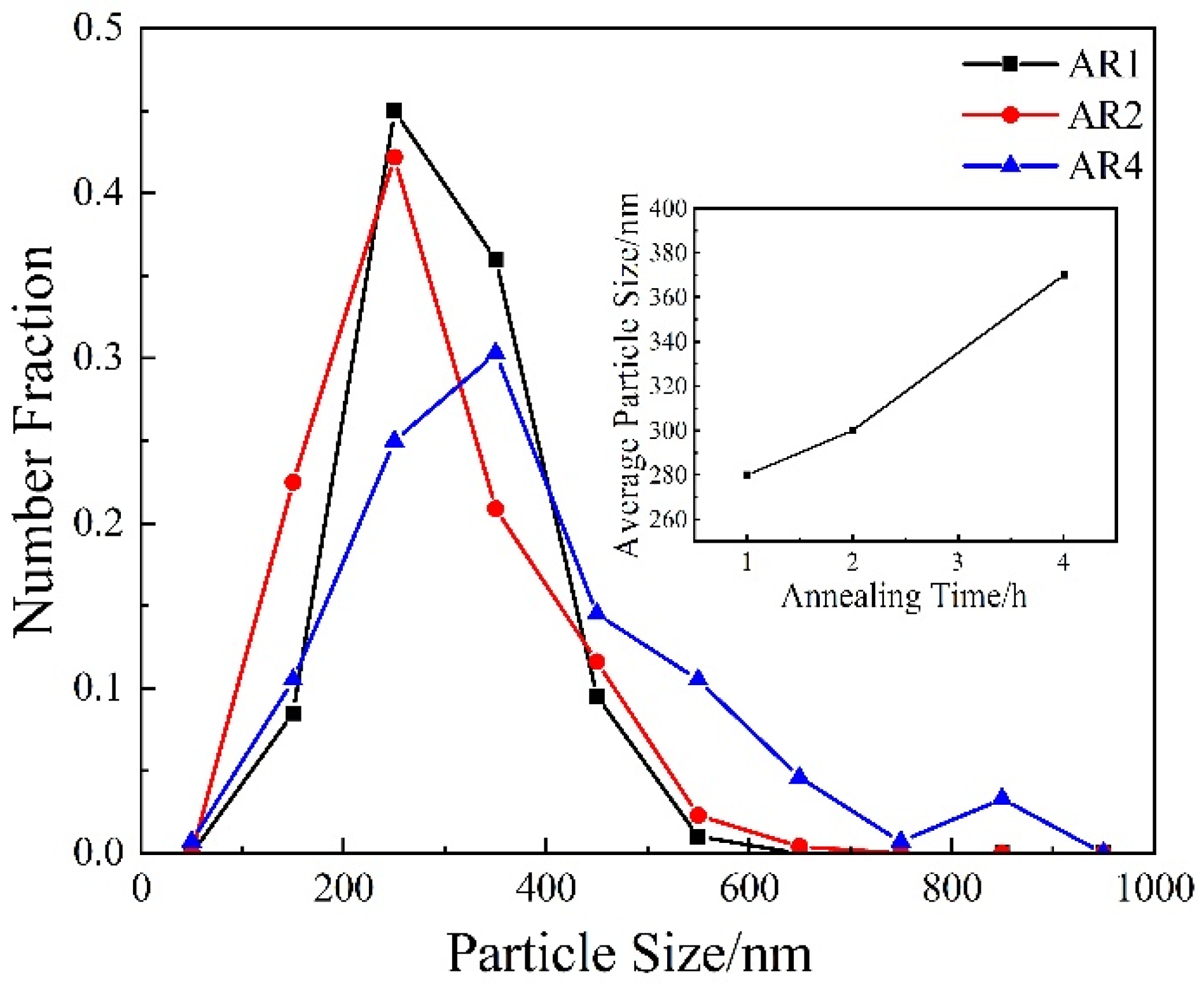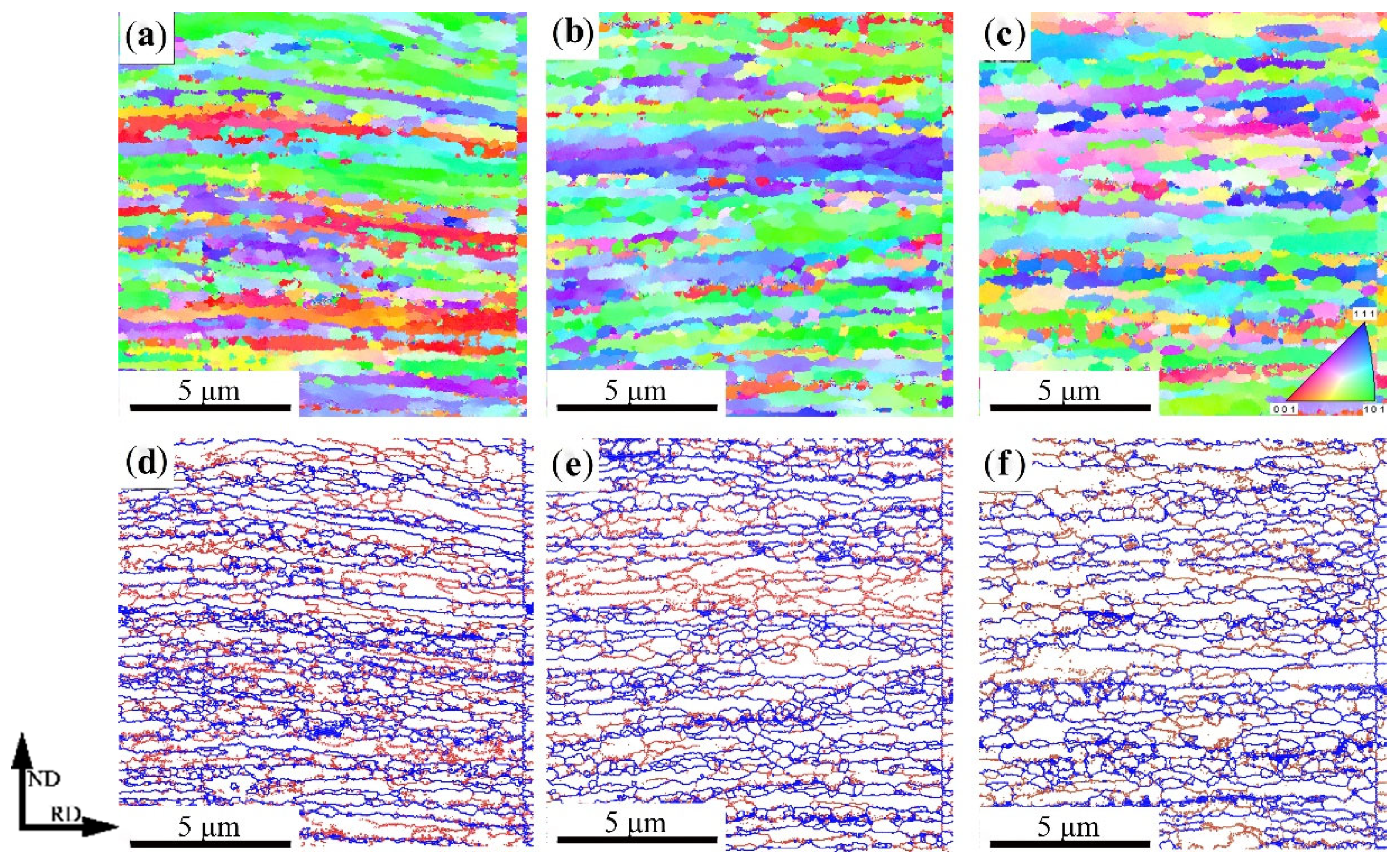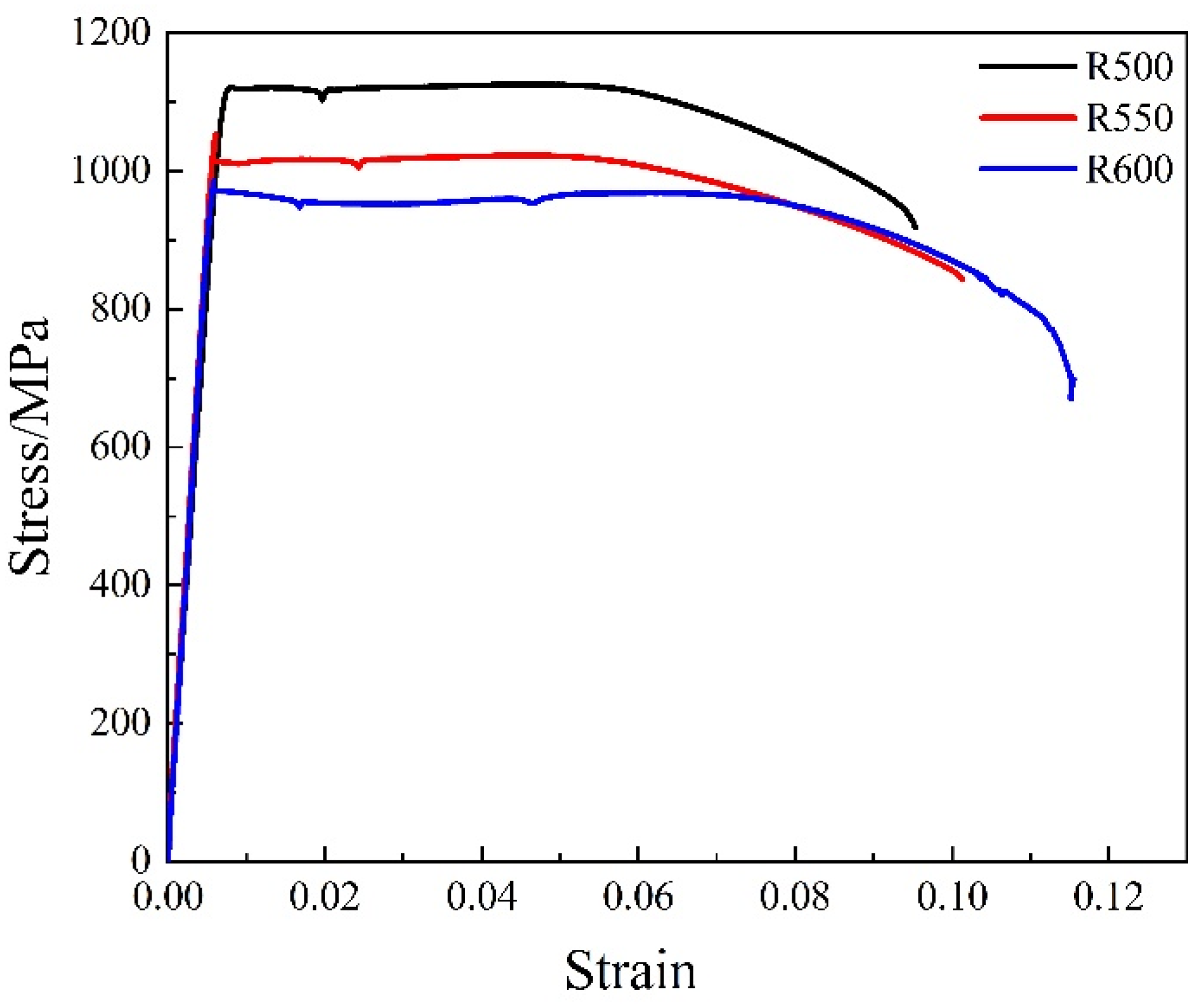Microstructure Evolution and Mechanical Properties of Medium Carbon Martensitic Steel during Warm Rolling and Annealing Process
Abstract
:1. Introduction
2. Materials and Methods
3. Results and Analysis
3.1. Martensitic Microstructure Evolution during Warm Rolling and Annealing
3.1.1. SEM Observation and Analysis
3.1.2. EBSD Observation and Analysis
3.2. Mechanical Properties of Martensitic Steel after Warm Rolling and Annealing
4. Conclusions
- (1)
- After warm rolling at 500 °C, 550 °C, and 600 °C, the martensite of medium carbon martensite steel was decomposed. When warm-rolled at 500 °C, 550 °C, and 600 °C, the average ferrite grain size was 0.41 μm, 0.44 μm, and 0.53 μm, respectively, and the proportion of HAGBs was 61.2%, 64.7%, and 66.8%, respectively. The room temperature tensile strength of the warm-rolled samples was above 950 MPa, accompanied by the total elongation of about 10%, which is of great value for application to a certain extent.
- (2)
- The samples were annealed at 600 °C after warm rolling. As the holding time increased, the fraction of cementite particles in the grains decreased, and the size of cementite particles at the grain boundaries increased. The yield strength of the annealed samples was above 600 MPa, and the total elongation was above 16%, which had a good combination of strength and plasticity.
- (3)
- The yield-to-tensile strength ratio of the samples after warm rolling and annealing at 600 °C for 2 h at different strain rates was greater than 0.92, and it had a high yield strength, that is, greater than 600 MPa, which had good performance when used as a fastener.
Author Contributions
Funding
Institutional Review Board Statement
Informed Consent Statement
Data Availability Statement
Acknowledgments
Conflicts of Interest
References
- Islam, T.; Rashed, H.M.M.A. Classification and Application of Plain Carbon Steels. In Reference Module in Materials Science and Materials Engineering; Elsevier: Amsterdam, The Netherlands, 2019. [Google Scholar] [CrossRef]
- Huang, M.X.; He, B.B. Alloy design by dislocation engineering. J. Mater. Sci. Technol. 2018, 34, 417–420. [Google Scholar] [CrossRef]
- Chen, X.; Wang, F.; Li, C.; Liu, S. Effect of Niobium on Microstructure and Mechanical Properties of Nb–Ti Microalloyed Carbide-Free Bainitic Steels. In TMS 2019 148th Annual Meeting & Exhibition Supplemental Proceedings; Springer: Cham, Switzerland, 2019; pp. 549–560. [Google Scholar] [CrossRef]
- Urtsev, V.N.; Kornilov, V.L.; Shmakov, A.V.; Krasnov, M.L.; Stekanov, P.A.; Platov, S.I.; Mokshin, E.D.; Urtsev, N.V.; Schastlivtsev, V.M.; Razumov, I.K.; et al. Formation of the Structural State of a High-Strength Low-Alloy Steel upon Hot Rolling and Controlled Cooling. Phys. Met. Metall. 2020, 120, 1233–1241. [Google Scholar] [CrossRef]
- Wang, Q.; Zhang, S.; Zhang, C.H.; Wang, J.Q.; Shahzad, M.B.; Chen, H.T.; Chen, J. A high strength low alloy steel fabricated by direct laser deposition. Vacuum 2019, 161, 225–231. [Google Scholar] [CrossRef]
- Tang, S.; Liu, Z.Y.; Wang, G.D.; Misra, R.D.K. Microstructural evolution and mechanical properties of high strength microalloyed steels: Ultra Fast Cooling (UFC) versus Accelerated Cooling (ACC). Mater. Sci. Eng. A 2013, 580, 257–265. [Google Scholar] [CrossRef]
- Feng, H.; Cai, L.; Wang, L.; Zhang, X.; Fang, F. Microstructure and strength in ultrastrong cold-drawn medium carbon steel. J. Mater. Sci. Technol. 2022, 97, 89–100. [Google Scholar] [CrossRef]
- Estrin, Y.; Vinogradov, A. Extreme grain refinement by severe plastic deformation: A wealth of challenging science. Acta Mater. 2013, 61, 782–817. [Google Scholar] [CrossRef]
- Song, R.; Ponge, D.; Raabe, D.; Speer, J.G.; Madock, D.K. Overview of processing, microstructure and mechanical properties of ultrafine grained bcc steels. Mater. Sci. Eng. A 2006, 441, 1–17. [Google Scholar] [CrossRef]
- Sha, G.; Tugcu, K.; Liao, X.Z.; Trimby, P.W.; Murashkin, M.Y.; Valiev, R.Z.; Ringer, S.P. Strength, grain refinement and solute nanostructures of an Al–Mg–Si alloy (AA6060) processed by high-pressure torsion. Acta Mater. 2014, 63, 169–179. [Google Scholar] [CrossRef]
- Ghasemi-Nanesa, H.; Nili-Ahmadabadi, M.; Mirsepasi, A.; Zamani, C. Nano- and microvoid formation in ultrafine-grained martensitic Fe-Ni-Mn steel after severe cold rolling. Met. Mater. Int. 2014, 20, 201–205. [Google Scholar] [CrossRef]
- Poorganji, B.; Miyamoto, G.; Maki, T.; Furuhara, T. Formation of ultrafine grained ferrite by warm deformation of lath martensite in low-alloy steels with different carbon content. Scr. Mater. 2008, 59, 279–281. [Google Scholar] [CrossRef]
- Hosseini, S.M.; Najafizadeh, A.; Kermanpur, A. Producing the nano/ultrafine grained low carbon steel by martensite process using plane strain compression. J. Mater. Process. Technol. 2011, 211, 230–236. [Google Scholar] [CrossRef]
- Tianfu, J.; Yuwei, G.; Guiying, Q.; Qun, L.; Tiansheng, W.; Wei, W.; Furen, X.; Dayong, C.; Xinyu, S.; Xin, Z. Nanocrystalline steel processed by severe rolling of lath martensite. Mater. Sci. Eng. A 2006, 432, 216–220. [Google Scholar] [CrossRef]
- Ueji, R.; Tsuji, N.; Minamino, Y.; Koizumi, Y. Effect of rolling reduction on ultrafine grained structure and mechanical properties of low-carbon steel thermomechanically processed from martensite starting structure. Sci. Technol. Adv. Mater. 2016, 5, 153–162. [Google Scholar] [CrossRef] [Green Version]
- Wang, C.Y.; Li, X.D.; Han, S.; Zhang, L.; Chang, Y.; Cao, W.Q.; Dong, H. Warm Stamping Technology of the Medium Manganese Steel. Steel Res. Int. 2018, 89. [Google Scholar] [CrossRef]
- Calcagnotto, M.; Ponge, D.; Raabe, D. Ultrafine grained ferrite/martensite dual phase steel fabricated by large strain warm deformation and subsequent intercritical annealing. ISIJ Int. 2008, 48, 1096–1101. [Google Scholar] [CrossRef] [Green Version]
- Chen, X. On the Ohno-Wang kinematic hardening rules for multiaxial ratcheting modeling of medium carbon steel. Int. J. Plast. 2005, 21, 161–184. [Google Scholar] [CrossRef]
- O’Brien, J.M.; Hosford, W.F. Spheroidization cycles for medium carbon steels. Metall. Mater. Trans. A 2002, 33, 1255–1261. [Google Scholar] [CrossRef]
- Lu, K. Stabilizing nanostructures in metals using grain and twin boundary architectures. Nat. Rev. Mater. 2016, 1, 16019. [Google Scholar] [CrossRef]
- Storojeva, L.; Kaspar, R.; Ponge, D. Effects of heavy warm deformation on microstructure and mechanical properties of a medium carbon ferritic-pearlitic steel. ISIJ Int. 2004, 44, 1211–1216. [Google Scholar] [CrossRef]
- Lee, T.; Park, C.H.; Lee, D.L.; Lee, C.S. Enhancing tensile properties of ultrafine-grained medium-carbon steel utilizing fine carbides. Mater. Sci. Eng. A 2011, 528, 6558–6564. [Google Scholar] [CrossRef]
- Wiskel, J.B.; Ma, J.; Valloton, J.; Ivey, D.G.; Henein, H. Strain aging on the yield strength to tensile strength ratio of UOE pipe. Mater. Sci. Technol. 2017, 33, 1319–1332. [Google Scholar] [CrossRef]
- Chen, P.; Wang, G.D.; Ceguerra, A.V.; Breen, A.J.; Ringer, S.P.; Xiong, X.C.; Lu, Q.; Wang, J.F.; Yi, H.L. Yield Strength Enhancement by Carbon Trapping in Ferrite of the Quenching and Partitioning Steel. Metall. Mater. Trans. A 2017, 49, 235–240. [Google Scholar] [CrossRef]
- Ma, X.L.; Huang, C.X.; Xu, W.Z.; Zhou, H.; Wu, X.L.; Zhu, Y.T. Strain hardening and ductility in a coarse-grain/nanostructure laminate material. Scr. Mater. 2015, 103, 57–60. [Google Scholar] [CrossRef] [Green Version]
- Wu, R.; Zaiser, M. Cell structure formation in a two-dimensional density-based dislocation dynamics model. Mater. Theory 2021, 5, 3. [Google Scholar] [CrossRef]
- Zhu, Y.C.; Niu, X.H.; Xiang, Y. Continuum dynamics of the formation, migration and dissociation of self-locked dislocation structures on parallel slip planes. J. Mech. Phys. Solids 2016, 96, 369–387. [Google Scholar] [CrossRef] [Green Version]
- Wu, R.H.; Tuzes, D.; Ispanovity, P.D.; Groma, I.; Hochrainer, T.; Zaiser, M. Instability of dislocation fluxes in a single slip: Deterministic and stochastic models of dislocation patterning. Phys. Rev. B 2018, 98, 054110. [Google Scholar] [CrossRef] [Green Version]
- Fan, H.; Wang, Q.; El-Awady, J.A.; Raabe, D.; Zaiser, M. Strain rate dependency of dislocation plasticity. Nat. Commun. 2021, 12, 1845. [Google Scholar] [CrossRef]
- Lu, J.Z.; Zhong, J.S.; Luo, K.Y.; Zhang, L.; Qi, H.; Luo, M.; Xu, X.J.; Zhou, J.Z. Strain rate correspondence of fracture surface features and tensile properties in AISI304 stainless steel under different LSP impact time. Surface Coat. Technol. 2013, 221, 88–93. [Google Scholar] [CrossRef]
- Çavuşoğlu, O.; Güral, A.; Gürün, H. Influence of strain rate on tensile properties and fracture behaviour of DP600 and DP780 dual-phase steels. Ironmak. Steelmak. 2016, 44, 773–781. [Google Scholar] [CrossRef]
- Garcia, C.I. 6—High strength low alloyed (HSLA) steels Every effort has been made to trace copyright holders and to obtain their permission for the use of copyright material. The publisher apologizes for any errors or omissions in the acknowledgements printed in this book and would be grateful if notified of any corrections that should be incorporated in future reprints or editions. In Automotive Steels; Rana, R., Singh, S.B., Eds.; Woodhead Publishing: Shaxton, UK, 2017; pp. 145–167. [Google Scholar] [CrossRef]








Publisher’s Note: MDPI stays neutral with regard to jurisdictional claims in published maps and institutional affiliations. |
© 2021 by the authors. Licensee MDPI, Basel, Switzerland. This article is an open access article distributed under the terms and conditions of the Creative Commons Attribution (CC BY) license (https://creativecommons.org/licenses/by/4.0/).
Share and Cite
Liu, G.; Liu, J.; Zhang, J.; Zhang, M.; Feng, Y. Microstructure Evolution and Mechanical Properties of Medium Carbon Martensitic Steel during Warm Rolling and Annealing Process. Materials 2021, 14, 6900. https://doi.org/10.3390/ma14226900
Liu G, Liu J, Zhang J, Zhang M, Feng Y. Microstructure Evolution and Mechanical Properties of Medium Carbon Martensitic Steel during Warm Rolling and Annealing Process. Materials. 2021; 14(22):6900. https://doi.org/10.3390/ma14226900
Chicago/Turabian StyleLiu, Guolong, Jingbao Liu, Jie Zhang, Minghe Zhang, and Yunli Feng. 2021. "Microstructure Evolution and Mechanical Properties of Medium Carbon Martensitic Steel during Warm Rolling and Annealing Process" Materials 14, no. 22: 6900. https://doi.org/10.3390/ma14226900




